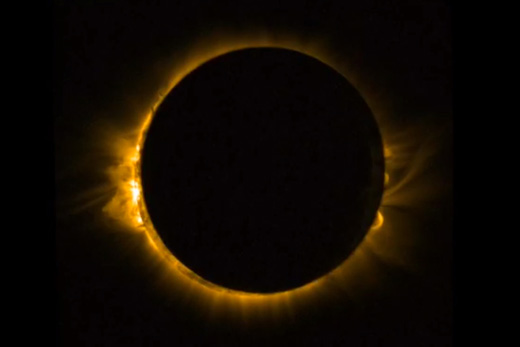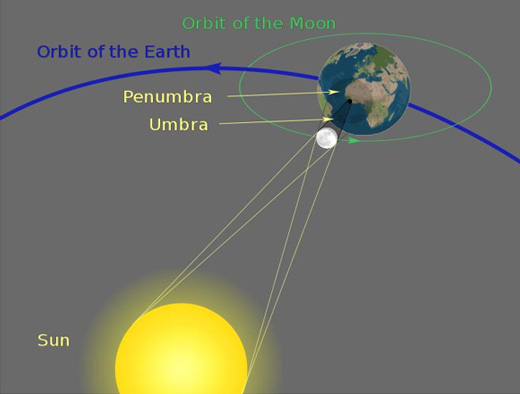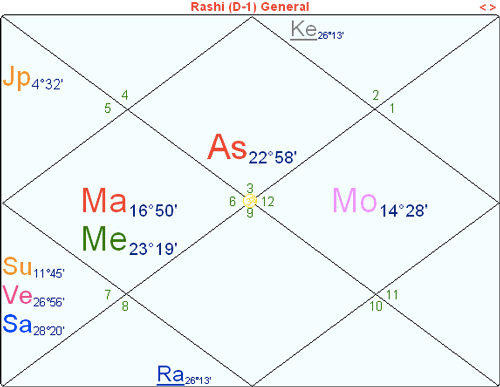Volume 28, 21 March 2015
“I've loved the stars too fondly to be fearful of the night”
A Spring Eclipse

Spring arrived along with a dramatic solar eclipse visible in totality in the Faroe Islands and Svalbard (Norway), and a partial solar eclipse visible in Europe, northern and eastern Asia and northern and western Africa.
What exactly is a solar eclipse and why couldn’t it be seen everywhere? An eclipse of the Sun can only happen at the New Moon when the Moon comes between the Earth and the Sun If the geometry is all lined up, the Moon’s shadow will fall on the earth and the Sun’s disc will be covered up partially or totally. The Moon has an outer shadow called the Penumbra and a dark inner shadow called the Umbra.

The 5% tilt of the Moon”s orbit with respect to the earth’s orbit causes the shadow to miss the earth most of the time - after all, a New Moon happens every month. However, on average of twice a year, some part of the shadow will fall on Earth and the eclipse will be visible in that particular locality. Some people could spend an entire lifetime and never see a total solar eclipse. Why is that?
Total solar eclipses are only visible along a narrow band of around 100 miles wide and 10,000 miles long. This amounts to less than 1% of the earth’s entire surface area. It is called the Path of Totality and you must be somewhere in this narrow path to see a totally eclipsed Sun. This is why you read about people swarming to all kinds of places to view this phenomenon as they may never have a chance to otherwise.
On April 4th, there will be a total lunar eclipse visible from the West Coast to the MidWest including Oklahoma and East Texas. It will be a partial eclipse for the East Coast. Unlike the solar eclipse, a lunar eclipse is visible to anyone as long as the eclipsed Moon is above the horizon. It too happens a couple of times a year but for a lunar eclipse, the Moon must be full and once again, with the right geometry all lined up so that the earth moving between the Moon and Sun effectively blocks the light of the Sun, with the Earth’s shadow falling on the Moon.
Those who want to know more about these fascinating astronomical light shows should check the Media Corner below for some very cool sites.
Gunas and Giving
We reveal so much about ourselves to knowledgable observers in the very simple acts of life. It is said that the way we conduct ourselves in speech and action is an expression of the balance of the three gunas dancing in our nature. Guna is one of those words that really has no English equivalent and can mean so many things depending on the context.
Many subscribers here will be familiar with the three guns referenced originally in Samkhya philosophy (enumerating the categories of all things). In this context, guna means a tendency or quality. The three are known as sattva, rajas and tamas. Once again, these are concepts with no English equivalent and require a developing awareness to really appreciate how they shape us.
Descriptions of the three gunas abound in many texts in this tradition but there is a remarkable chapter in the Bhagavad Gita describing how those with a dominance of one of the three will behave with respect to certain key functions in life such as food, religious practices, speech and charity.
I was especially struck by the descriptions of the intentions of a person in bestowing a gift. So many remedial measures involving charity and donations are recommended for relieving certain obstructive astrological combinations. It behooves the astrologer to understand and explain the intention behind such remedial measures. In a beautiful translation by Swami Dayananda Saraswati, it is said that “charity which is given to one from whom one does not expect a return, in the proper place, at the proper time and to a worthy recipient, thinking, - it is to be given - that is considered sattvika charity. On the other hand, that charity, which is given for the sake of being helped in return, or keeping in view a result to be gained later, and that which is fraught with pain (in the sense that you really don’t want to give it but you feel you are expected to give), this is considered rajasika. And that charity which is given without respect and contemptuously at the wrong place and wrong time, and to unworthy recipients, is called tamasika.”
Does this then mean that charity as a remedial measure is not efficacious as it most likely is at least partly rajasic and could even be tamasic? Swami-ji is a very practical man. When asked this kind of question, he usually responds with something along the lines of “fake it until you make it” indicating that on the path, we have to start where we are and evolve to a place where the wholeness is so complete that it is easy and natural to give in that joyous sattvic way without the need for return, recognition or even thanks.
A Charitable Man
There are a number of ways to see the inclination to be charitable in a Jyotisha chart. However, certain astrological combinations are rarely seen and should therefore be valued more - a tendency that we see in a material analogy among collectors who pay a fortune for a rare stamp.

Here is an example chart of a truly magnanimous giver with several good charitable combinations However, I am going to focus on the one that is rare due to the exactness of its formation. The combination is called a Srinatha Yoga and it is formed when the 9th lord, Mercury and Venus (three distinct grahas for a perfect formation) are swa, exalted or in a friend’s rashi while in kendras and/or trikonas. It sounds like it would be easy to find but it turns out to be rather rare unless you compromise with having either Venus or Mercury be the 9th lord reducing the necessity for three distinct grahas.
In the above chart, please notice that the 9th lord is Saturn and it is exalted in the fifth house, a trikona. Sitting with it is Venus who is swa in Libra. The third necessary graha is Mercury. Mercury is swa in Virgo in the fourth house, a kendra. Not only is this a perfect formation, all of the grahas are in the superior dignified states of swa and exaltation rather than in a friend’s rashi. They are also networked into many other auspicious yogas.
The owner of this amazing chart? Mr. Bill Gates.
The Media Corner
Enjoy the miracles of the universe right on your desktop with some wonderful astronomical sites.
For those interested in more details about eclipses - past and future - check out http://eclipse.gsfc.nasa.gov/eclipse.html. You will get detailed information about the paths of the solar eclipses, when eclipses will occur, what kind they will be etc. etc.
For topical astronomical viewing phenomenon, try http://earthsky.org. This site is not just astronomical but has beautiful videos and information on nature in general.
The site at http://shadowandsubstance.com has very cool animations which some might find very helpful for understanding astronomical events. They are currently featuring the upcoming lunar eclipse.
